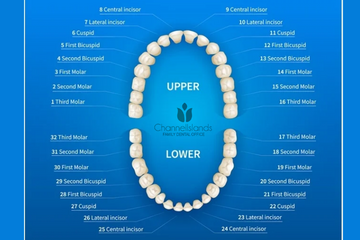Last Updated on: 4th December 2024, 12:21 pm
“Distal occlusion in piece 23” and “resin for change in piece 48” are phrases frequently heard when consulting the dentist to find out the condition of your oral health. This does not refer to the person having 48 teeth. The number of permanent teeth in an adult is 32. The primary (temporary) denture set has 20 teeth numbers.
The teeth number the dentist mentions during his inspection and assessment refers to the location of the tooth in the dental system, according to the quadrant and position of the tooth.
What does Dental Teeth Numbers Chart show?

Dental teeth numbering, using a table or dental chart, records information on specific teeth.
The numbering system makes it possible to identify and classify the diagnosis or condition of a dental piece, while at the same time, it favors effective communication between oral health professionals to facilitate the follow-up of the required treatment.
Worldwide, there are several tooth numbering systems:
- Zsigmondy-Palmer
- Universal numbering system
- Numbering of the FDI
- System Victor Haderup
- System Woelfel
- System MICAP system
Of the systems mentioned, the Zsigmondy-Palmer is the oldest as it appeared in 1861, It is also known as Palmer’s notation.
Much of these dental numbering systems focus on permanent teeth. To understand the primary (milk) dentition, there is also tooth numbering specifically for primary teeth.
The Universal Teeth Numbering System

In 1882, the German Julius Parreidt proposed a universal numbering system that designates primary and permanent teeth differently. This is the system that has been accepted by the American Dental Association (ADA) since 1968 and is frequently used by dentists in the United States. It is also known as the American system.
Although it is the most frequently used system, it presents a drawback: it does not classify supernumerary teeth, i.e., those in addition to the normal number of teeth, which is a frequent case in primary dentition.
But it also has an advantage: it follows a sequence of names, which makes it easy to locate the corresponding teeth.
Names of Permanent Teeth
Teeth are numbered in order from 1 to 32, starting from the posterior area of the first (upper right) quadrant. The third molar (wisdom tooth or wisdom tooth) is number 1 in the sequence. The left third molar (facing wisdom tooth) is piece number 16. In other words, the upper jaw has 16 pieces, 8 in each quadrant.
The lower jaw teeth follow a similar nomenclature. That is, the lower left third molar is number 17, and the opposite piece (lower right molar) is number 32.
The FDI System
The International Dental Federation (FDI) notation was introduced in 1970 and is the system used by the World Health Organization and most countries around the world except the United States.
Of note, the FDI is an independent worldwide organization representing dentists affiliated with various associations in more than 100 countries.
Teeth Numbers Chart by Quadrants:
To correctly understand and interpret the tooth numbering system, it is essential to understand the dental quadrants.
Oral health professionals divide the teeth numbers into four quadrants:
- Quadrant 1: upper right arch.
- Quadrant 2: upper left arch
- Quadrant 3: lower left arch
- Quadrant 4: lower right arch.
The distribution by quadrants allows quick identification of the corresponding dental piece. In the permanent dentition, each of the quadrants has 8 pieces, for a total of 32 teeth numbers.
The FDI system uses two numbers to identify the dental piece: the first digit indicates the quadrant and the second corresponds to its position in the quadrant, that is, the second number goes from 1 to 8 for the corresponding quadrant.
So, tooth 28 refers to piece number 8 of quadrant 2; in other words, the wisdom tooth is located in the upper left jaw. Piece 43 is in the lower right jaw and is one of the canine teeth.
The nomenclature for milk teeth
In primary teeth, each quadrant has 5 pieces, for a total of 20 teeth. In this case, the second digit only goes from 1 to 5, and the correspondence for the second digit is:
- 1 central incisor
- 2 lateral incisor
- 3 canine
- 4 first molar
- 5-second molar
What is the Dental Tooth Chart for?

The dental nomenclature, or the table of teeth numbers, allows the dentist to record the condition of a certain dental piece. Later, it will serve as a guide for the corresponding treatment. It is a fundamental tool for the dentist that minimizes mistakes in a diagnosis and subsequent procedure.
On your next visit to the dentist, you will now have the opportunity to better understand the assessment of your oral health and the corresponding diagnosis.
Contact us
If you have any questions about this or other topics, you can contact us at Channel Islands Family Dental as well as our page on Facebook. We look forward to your visit and we will make a timely diagnosis. Our dentists in Oxnard, Santa Paula, Ventura, Newbury Park, and Port Hueneme will be able to guide you toward the best treatment to take care of your health and give you back your best smile.
Bibliography
- ILERNA Official Vocational Training Center (2019). Dental nomenclature: the International Code (FDI). https://www.ilerna.es/blog/aprende-con-ilerna-online/sanidad/codigo-internacional-dientes-fdi/#A_la_practica_ejemplos_de_nomenclatura_de_dientes
- Universal Numbering System. Wikipedia. Information updated in 2022. Retrieved from https://en.wikipedia.org/wiki/Universal_Numbering_System in December 2022
- Rodríguez, F. J / Cerviño, S (2009). Multiple Distomolar Supernumerary Teeth Advances in Odontostomatology, Volume 25 – No. 6. https://scielo.isciii.es/scielo.php?script=sci_arttext&pid=S0213-12852009000600003
- Sahi, Akshima (2019). Universal Numbering System for Teeth. https://www.news-medical.net/health/Universal-Numbering-System-for-Teeth.aspx














